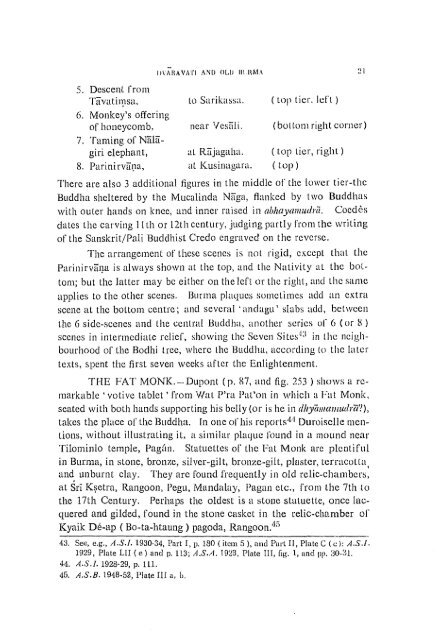The Journal of the Siam Society Vol. LIII, Part 1-2, 1965 - Khamkoo
The Journal of the Siam Society Vol. LIII, Part 1-2, 1965 - Khamkoo
The Journal of the Siam Society Vol. LIII, Part 1-2, 1965 - Khamkoo
You also want an ePaper? Increase the reach of your titles
YUMPU automatically turns print PDFs into web optimized ePapers that Google loves.
5.<br />
6.<br />
7.<br />
8.<br />
Descent from<br />
Tavatin.1sa,<br />
Monkey's <strong>of</strong>fering<br />
<strong>of</strong> honeycomb,<br />
Taming <strong>of</strong> Natagiri<br />
elephant,<br />
Parini rvui.Hl,<br />
IJ\'AHAVATI AND OLIJ II\ liMA<br />
to Sarikassa.<br />
ncar Vcs'iili.<br />
at Rajagaha.<br />
at Kusinagara.<br />
(top tier. lef't)<br />
(bottom right corner)<br />
(top tier, right)<br />
(top)<br />
<strong>The</strong>re are also 3 additional figures in <strong>the</strong> middle ol' <strong>the</strong> lower tier-<strong>the</strong><br />
Buddha sheltered by <strong>the</strong> Mucalinda Naga, flanked by two Buddhas<br />
with outer hands on knee, and inner raised in abhayamzulra. Coedes<br />
dates <strong>the</strong> carving 11th or 12th century, judging partly from <strong>the</strong> writing<br />
<strong>of</strong> <strong>the</strong> Sanskrit/Pali Buddhist Credo engraved on <strong>the</strong> reverse.<br />
<strong>The</strong> arrangement <strong>of</strong> <strong>the</strong>se scenes is not rigid, except that <strong>the</strong><br />
ParinirvaJ}a is always shown at <strong>the</strong> top, and <strong>the</strong> Nativity at <strong>the</strong> bottom;<br />
but <strong>the</strong> latter may be ei<strong>the</strong>r on <strong>the</strong> left or <strong>the</strong> right, and <strong>the</strong> same<br />
applies to <strong>the</strong> o<strong>the</strong>r scenes. Burma plaques sometimes add an extra<br />
scene at <strong>the</strong> bottom centre; and several 'andagu' slabs udd, bet ween<br />
<strong>the</strong> 6 side-scenes and <strong>the</strong> central Buddha, ano<strong>the</strong>r series or 6 (or !:l )<br />
scenes in intermediate relief', showing <strong>the</strong> Seven Sites' 1 : 1 in <strong>the</strong> ncighboUJ·hood<br />
<strong>of</strong> <strong>the</strong> Bodhi tree, where <strong>the</strong> Buddha, according to <strong>the</strong> later<br />
texts, spent <strong>the</strong> first seven weeks after <strong>the</strong> Enlightenment.<br />
THE FAT MONK.-·· Dupont ( p. 87, and fig. 253 ) shows a remarkable'<br />
votive tablet' from Wat P'ru Pat'on in which a Fat Monk,<br />
seated with both hands supporting his belly (or is he in dhyamanuulra'!),<br />
takes <strong>the</strong> place <strong>of</strong> <strong>the</strong> Buddha. rn one <strong>of</strong> his reports 4·1 Duroise!Ie mentions,<br />
without illustrating it, a similar plaque round in a mound near<br />
Tilominlo temple, Pag{tn. Statuettes <strong>of</strong> <strong>the</strong> Fat Monk arc plentiful<br />
in Burma, in stone, bron?.c, silver-gilt, bronze-gilt, plaster, terracotta<br />
an~ unburnt clay. <strong>The</strong>y arc found frequently in old relic-chambers:<br />
at Sri K~etra, Rangoon, Pegu, Mandalay, Pagan etc., from <strong>the</strong> 7th to<br />
<strong>the</strong> 17th Century. Perhaps <strong>the</strong> oldest is a stone statuette, once lacquered<br />
and gilded, found in <strong>the</strong> stone casket in <strong>the</strong> relic-chamber or<br />
Kyaik De-ap ( Bo-ta-htaung) pagoda, Rangoon. 4 ii<br />
'13. See, e.g., A .S.l. 1930·34, <strong>Part</strong> I, p. 180 (item 5 ), and <strong>Part</strong> II, Plate C (e): A .S.J.<br />
1929, Plate LII (e) and p. 113; A.S.A. 1923, Plate llJ, f1g. 1, and pp. ao.:~1.<br />
44. A.S.!. 1928-29, p. 111.<br />
45. A.S.B. 1948-52, Plate III a, o.

















